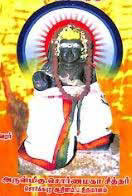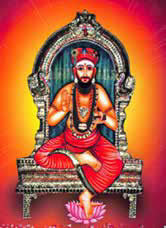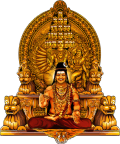KAILĀSA Paramparagatha Sarvajnapeetha Suvarnapeetha
Swargapura Sāmrājya
The KAILĀSA Paramparagatha Sarvajnapeetha Suvarnapeetha Swargapura Sāmrājya is a expansion of the Madurai Aadheenam, proliferating the tradition of Shaiva Siddhanta across present day Kerala and other regions of South India with the Chera Sāmrājya. Originating from Paramaśiva in His incarnation as Swarna Siddhar, the enlightenment ecosystem was built on the jiva samadhi (final resting place which continues to radiate energy) of Swarna Siddhar and his four disciples. Today, there are 40 branches spanning across South India. Nearly at the brink of extinction due to continuous invasion, persecution, and subjugation, it was revived by The Supreme Pontiff of Hinduism Bhagavān Nithyānanda Paramashivam as the 23rd Guru Maha Sannidhanam.
Origins
The Shyamala Peetha Sarvajnapeetha is one of the oldest kingdoms and traditions. The Madurai Aadheenam, mentioned in numerous ancient Tamil texts dated 2000 years before, followed the Vedic Tradition. Vedanta and Shaiva Siddhantha are philosophies that are branches of Madurai Aadheenam, as they evolved after the Vedic Tradition and Shyamala Peetha Sarvajnapeetha.
Being one of the oldest traditions with an impressive presence all over the civilization, Madurai Aadheenam is the parent of numerous other Aadheenams and traditions, including the Swargapuram Aadheenam and Thiruvavaduthurai Aadheenam.
The Swargpuram Aadheenam or Kailāsa Paramparagatha Sarvajñapiṭha Suvarnapeetha Swargapura Sāmrājya is a descended from the Madurai Aadheenam and follows the philosophy of Shaiva Siddhanta.
KAILĀSA Paramparagatha Sarvajnapeetha Suvarnapeetha Swargapura Sāmrājya
- The KAILĀSA Paramparagatha Sarvajnapeeṭha Suvarnapeetha Swargapura Sāmrājya was built on the jiva samadhi (the final resting place which continues to radiate energy) of Swarna Siddhar.
- It was part of the Kingdom of Chera, which was predominantly in the state of Kerala.
- It also has 5 Śiva temples built on the jiva samadhi of Swarna Siddhar’s disciples.
- The presiding deities are Paramaśiva as Arulmigu Maruthuvaneshwarar Swami and His Divine Consort, Paramaśiva Śakti as Śri Atchayanayaki Amman.

Arulmigu Maruthuvaneshwarar Swami and Śri Atchayanayaki Amman
Swarna Siddhar
- Swarna Siddhar was known for extraordinary power manifestation abilities
- He manifested gold for the poor
- He left his body along with the rare and powerful naagam (a snake that used to live with him).
- His 5 disciples also attained jīva samādhi in their respective places, cognizing through their power of enlightenment that the Siddhar has attained jīva samādhi (rested his body), on the same day.

Deity of Swarna Siddhar
Revival in 12 Century CE
Śri La Śri Azhagiya Tiruchittrambala Desikar, a great Mahan (enlightened being), revived the Swargapura Sāmrājya, after inheriting the land from his Guru, Sage Thamba. Sage Thamba, one of the 18 Siddhas initiated by Paramaśiva, healed the Chera king’s daughter, earning the gratitude of the king who gifted him great wealth and land.
After Arulmigu Azhagiya Tiruchitrambala Desikar, there has been an unbroken lineage of Pontiffs, keeping this ecosystem alive. There are 40 branches affiliated to this illustrious kingdom, propagating the philosophy of Shaiva Siddhanta across South India.

Śri La Śri Azhagiya Tiruchittrambala Desikar
The great descendant of Paramaśiva
Śri La Śri Azhagiya Tiruchittrambala Desikar the great descendant of Paramaśiva ruled for more than 200 glorious years. Under his rule, the Kingdom of Swargapura flourished with:
- Abundant lands
- An Anna dhan mutt
- Educational institutions
- Charity organizations
- Felicitation of scholarly poets
- Helping the needy who come to the mutt
- Teaching of Shaiva Siddhanta
- Hospitals
- Giving protection and helping the orphans
- A spatika (crystal) Linga and the pūjā methods to offer worship to it
- Teaching the traditions specific to the lineage of acharyas (rulers), and enlightenment.
